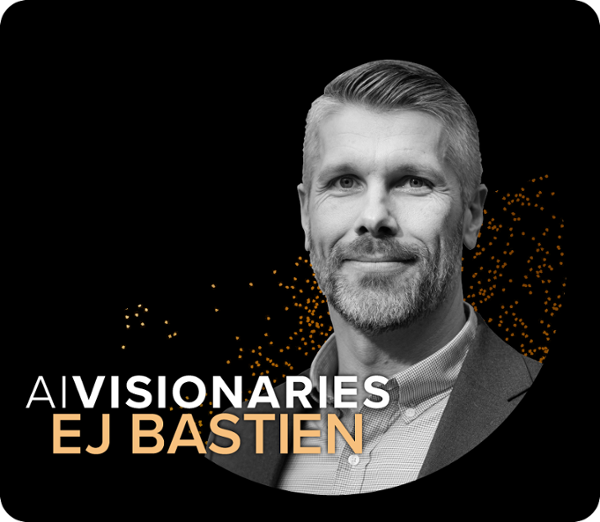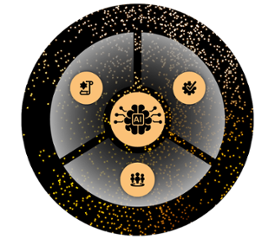Today, E.J. Bastien leads the Litigation Support function in Microsoft’s Litigation group. He’s also a 2025 AI Visionary. But back in the day, he led a life on the road, playing guitar for a number of DIY bands.
With an origin story like that, a feature about E.J.’s creative contributions to the legal field needs some extra punch. So, the following is The Set List of a Tech Pro.
Track 1: IT STARTED IN A DIY BAND
E.J. Bastien brings artistry to his desk job.
In his touring days, E.J. found himself learning how to do what he loves with no money, while building and fixing gear and facing lots of problems that no one else could solve. These ... opportunities—okay, setbacks—from his band days left him with a unique and scrappy skillset.
Take, for example, E.J.’s ability to connect with other creative problem solvers. Or the standard he sets for himself on delivering the best possible outcome even with slim resources and high expectations. Lo and behold, twenty years later, E.J. has seen many of these same passions engaged in his litigation career.
E.J. finds ways to extract data from systems with no defined method. He develops processes to maximize efficiencies on tight budgets and with high expectations. And he’s built a web of connections to help him chip away at hefty technological challenges.
He describes this crossover best: “Much like the music scene I grew up in, the e-discovery community is full of amazing people who are as approachable as they are talented, who inspire and build off one another, who support each other as individuals and as a community in whole.”
Track 2: SWEET AI OF MINE
In a place beyond the hype around AI, E.J. predicts huge efficiency gains.
In the legal data industry, generative AI is carrying serious weight. You know it; E.J. knows it. It’s changing everything.
E.J. points to a place beyond the hype, where, when people pragmatically apply available capabilities, the value of their efforts has more density. Spending less time sifting through the noise means more engagement with the richest details of each case.
Already, we’ve seen AI automate and accelerate time-consuming tasks, improve productivity, reduce distractions, and bring crucial insights to the surface. AI is creating room to refocus human talent, and legal data pros are finally doing the work they love to do, not just the work that they have to do.
It’s a monumental shift in workload that E.J. wholeheartedly believes in.
“So much time is spent managing low-value, irrelevant data. AI can help rebalance the efforts so we can spend more time on the most important elements of our roles,” he tells us. “Everyone I know has too much to do; I am optimistic AI will help us scale to our full potential.”
Track 3: AIN’T NO DATA CHALLENGE HIGH ENOUGH
Still, E.J. sees fuller potential.
He’s the kind of innovator and leader who acknowledges big potential and believes it’s in reach. At Microsoft, E.J. leads a team of project managers, paralegals, corporate records compliance managers, and engineers who sit at the crux of technology and practice. Responsible for developing, executing, and continually improving the discovery-response workstreams at one of the most dynamic tech companies in the world, E.J. and his team are often some of the first to face big challenges. They brace for impact the best way they know how: trusty tech.
Emerging technology empowers E.J.’s team with optimism. When a challenge arises and calls for experimentation or navigation of novel data types, they’re not just equipped—they’re excited.
“We use technology to scale the ever-expanding data volumes and sources across a widely varied docket, automating complex and meticulous tasks, and monitoring and measuring our impact,” E.J. says.
Track 4: OPTIMIZING, DAY AND NIGHT
AI is more than just a trouble shooter for E.J.’s team.
At Microsoft, it’s also a trusted research partner, a tracker, a tool for summarizing. It helps E.J. and team identify items that need special handling or attention. It suggests areas for automation, predicts relevance, assists in building new solutions—the list goes on. The point here is, they’re finding new uses for AI on a daily basis.
E.J. holds a lot of hope for where this tool can take the legal data world: “I hope AI can deweaponize discovery and help us achieve the altruistic goals of surfacing truth, quickly and efficiently. It should help us communicate and share knowledge with greater clarity and less effort, from project status updates to negotiation with opposing counsel.”
Track 5: P-R-O-D-U-C-T-I-V-I-T-Y
E.J. wonders: what if we’re not meant to be the experts?
For an end user of AI, the obsession with its technical underpinnings, though a good impulse in many ways (and necessary in some instances), could double as a roadblock. E.J. thinks some people might be missing the point.
He uses the example of cars and computers: we don’t all need a detailed understanding of precisely how they work in order to use them—so why the emphasis on how AI works?
“I think we’d become much more productive if we focused our energies on increasing our effectiveness actually using it—finding ways to get the best results and methods to validate their accuracy.”
Track 6: THE BALLAD OF A LEGAL DATA PRO
We’ll leave you with these wise and compelling words from E.J. (his exit ballad, if you will):
“Don’t wait for someone else to do it for you. Technology should be a tool, not just a practice in and of itself, and you should use it to work for you, not the other way around. Knowing the actual goals and nuances of your space can have higher value than pure technical skills, so as you start to take chances, you can recognize issues and self-correct with more specificity and precision than if you’re leaning on someone else too heavily. You can learn it as you go, and you can get meaningful results with far less expertise than you might expect. And with generative AI advancements, things can come together far faster than ever before. Don’t let perfection be the enemy of the good, but pay close attention.”
Graphics for this article were created by Sarah Vachlon.












